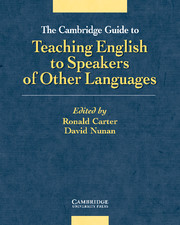Book contents
- Frontmatter
- Contents
- List of figures
- List of abbreviations
- Acknowledgements
- List of contributors
- Introduction
- Chapter 1 Listening
- Chapter 2 Speaking
- Chapter 3 Reading
- Chapter 4 Writing
- Chapter 5 Grammar
- Chapter 6 Vocabulary
- Chapter 7 Discourse
- Chapter 8 Pronunciation
- Chapter 9 Materials development
- Chapter 10 Second language teacher education
- Chapter 11 Psycholinguistics
- Chapter 12 Second language acquisition
- Chapter 13 Bilingualism
- Chapter 14 Sociolinguistics
- Chapter 15 Computer-assisted language learning
- Chapter 16 Observation
- Chapter 17 Classroom interaction
- Chapter 18 English for academic purposes
- Chapter 19 English for specific purposes
- Chapter 20 Assessment
- Chapter 21 Evaluation
- Chapter 22 Syllabus design
- Chapter 23 Language awareness
- Chapter 24 Language learning strategies
- Chapter 25 Task-based language learning
- Chapter 26 Literature in the language classroom
- Chapter 27 Genre
- Chapter 28 Programme management
- Chapter 29 Intercultural communication
- Chapter 30 On-line communication
- Postscript: The ideology of TESOL
- Glossary
- References
- Index
Chapter 18 - English for academic purposes
Published online by Cambridge University Press: 07 September 2010
- Frontmatter
- Contents
- List of figures
- List of abbreviations
- Acknowledgements
- List of contributors
- Introduction
- Chapter 1 Listening
- Chapter 2 Speaking
- Chapter 3 Reading
- Chapter 4 Writing
- Chapter 5 Grammar
- Chapter 6 Vocabulary
- Chapter 7 Discourse
- Chapter 8 Pronunciation
- Chapter 9 Materials development
- Chapter 10 Second language teacher education
- Chapter 11 Psycholinguistics
- Chapter 12 Second language acquisition
- Chapter 13 Bilingualism
- Chapter 14 Sociolinguistics
- Chapter 15 Computer-assisted language learning
- Chapter 16 Observation
- Chapter 17 Classroom interaction
- Chapter 18 English for academic purposes
- Chapter 19 English for specific purposes
- Chapter 20 Assessment
- Chapter 21 Evaluation
- Chapter 22 Syllabus design
- Chapter 23 Language awareness
- Chapter 24 Language learning strategies
- Chapter 25 Task-based language learning
- Chapter 26 Literature in the language classroom
- Chapter 27 Genre
- Chapter 28 Programme management
- Chapter 29 Intercultural communication
- Chapter 30 On-line communication
- Postscript: The ideology of TESOL
- Glossary
- References
- Index
Summary
Introduction
Over the past 25 years TESL/TEFL in universities/colleges and other academic settings – or in programmes designed to prepare non-native users of English for English-medium academic settings – has grown into a multi-million-dollar enterprise around the world. Teaching those who are using English for their studies differs from teaching English to those who are learning for general purposes only, and from teaching those who are learning for occupational purposes.
English for academic purposes (EAP) is not only a teaching approach. It is also a branch of applied linguistics consisting of a significant body of research into effective teaching and assessment approaches, methods of analysis of the academic language needs of students, analysis of the linguistic and discoursal structures of academic texts, and analysis of the textual practices of academics.
Background
The practice of teaching EAP has been with us for a long time – wherever individual teachers of non-native students in academic contexts have taught with a view to the context rather than only to the language – but the term ‘EAP’ first came into general use through the British organisation SELMOUS (Special English Language Materials for Overseas University Students), which was formed in 1972. Although the organisation's first collection of papers from its annual meeting was titled English for academic purposes (Cowie and Heaton 1977), it didn't change its name to include the term until 1989, when it became BALEAP (British Association of Lecturers in English for Academic Purposes).
- Type
- Chapter
- Information
- Publisher: Cambridge University PressPrint publication year: 2001
- 22
- Cited by



